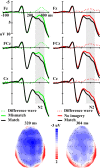The effects of visual imagery on face identification: an ERP study
- PMID: 23162452
- PMCID: PMC3492902
- DOI: 10.3389/fnhum.2012.00305
The effects of visual imagery on face identification: an ERP study
Abstract
The present study tested the hypothesis that the effects of mental imagery on subsequent perception occur at a later matching stage in perceptual identification, but not in the early perceptual stage as in perceptual detection. The behavioral results suggested that the effect of visual imagery on visual identification is content-specific, i.e., imagining a congruent face facilitates face identification, whereas a mismatch between imagery and perception leads to an interference effect. More importantly, the ERP results revealed that a more negative N2 response to the subsequent visual face stimuli was elicited over fronto-central sites in the mismatch and no-imagery conditions as compared to that in the match condition, with the early P1 and N170 components independent of manipulations. The latency and distribution of the neural effects demonstrate that the matching step, but not the earlier perceptual process, is affected by the preceding visual imagery in the context of face identification. We discuss these results in a broader context that the imagery-perception interaction may depend on task demand.
Keywords: N170; N2; event-related potentials; face identification; matching; visual imagery.
Figures




Similar articles
-
Mental imagery of face enhances face-sensitive event-related potentials to ambiguous visual stimuli.Biol Psychol. 2017 Oct;129:16-24. doi: 10.1016/j.biopsycho.2017.07.013. Epub 2017 Jul 22. Biol Psychol. 2017. PMID: 28743457
-
Electrophysiological potentials reveal cortical mechanisms for mental imagery, mental simulation, and grounded (embodied) cognition.Front Psychol. 2012 Sep 14;3:329. doi: 10.3389/fpsyg.2012.00329. eCollection 2012. Front Psychol. 2012. PMID: 23049515 Free PMC article.
-
Visual mental imagery and perception produce opposite adaptation effects on early brain potentials.Neuroimage. 2008 Oct 1;42(4):1714-27. doi: 10.1016/j.neuroimage.2008.07.004. Epub 2008 Jul 16. Neuroimage. 2008. PMID: 18674625
-
Does physical interstimulus variance account for early electrophysiological face sensitive responses in the human brain? Ten lessons on the N170.Neuroimage. 2008 Feb 15;39(4):1959-79. doi: 10.1016/j.neuroimage.2007.10.011. Epub 2007 Oct 22. Neuroimage. 2008. PMID: 18055223 Review.
-
[Neural mechanisms of face recognition: an event-related potential study].Brain Nerve. 2012 Jul;64(7):717-26. Brain Nerve. 2012. PMID: 22764343 Review. Japanese.
Cited by
-
Auditory to Visual Cross-Modal Adaptation for Emotion: Psychophysical and Neural Correlates.Cereb Cortex. 2017 Feb 1;27(2):1337-1346. doi: 10.1093/cercor/bhv321. Cereb Cortex. 2017. PMID: 26733537 Free PMC article.
-
The format of mental imagery: from a critical review to an integrated embodied representation approach.Cogn Process. 2019 Aug;20(3):277-289. doi: 10.1007/s10339-019-00908-z. Epub 2019 Feb 23. Cogn Process. 2019. PMID: 30798484 Review.
-
The role of imagery in threat-related perceptual decision making.Emotion. 2020 Dec;20(8):1495-1501. doi: 10.1037/emo0000610. Epub 2019 Jun 13. Emotion. 2020. PMID: 31192666 Free PMC article.
-
Electrocorticography Reveals Enhanced Visual Cortex Responses to Visual Speech.Cereb Cortex. 2015 Nov;25(11):4103-10. doi: 10.1093/cercor/bhu127. Epub 2014 Jun 5. Cereb Cortex. 2015. PMID: 24904069 Free PMC article.
-
An RCT to treat learning impairment in multiple sclerosis: The MEMREHAB trial.Neurology. 2013 Dec 10;81(24):2066-72. doi: 10.1212/01.wnl.0000437295.97946.a8. Epub 2013 Nov 8. Neurology. 2013. PMID: 24212393 Free PMC article. Clinical Trial.
References
-
- Bruce V., Young A. (1986). Understanding face recognition. Br. J. Psychol. 77, 305–327 - PubMed
-
- Craver-Lemley C., Arterberry M. E., Reeves A. (1997). Effects of imagery on vernier acuity under conditions of induced depth. J. Exp. Psychol. Hum. Percept. Perform. 23, 3–13 - PubMed
-
- Craver-Lemley C., Reeves A. (1987). Visual imagery selectively reduces vernier acuity. Perception 16, 599–614 - PubMed
LinkOut - more resources
Full Text Sources

